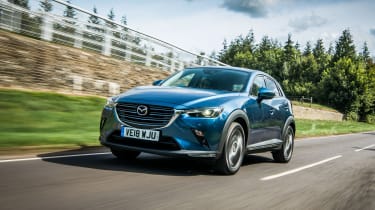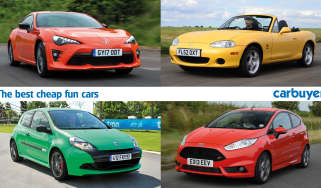Mazda CX-3 SUV (2015-2020) - Engines, drive & performance
Weight saving means the Mazda CX-3 is agile and fun to drive, while efficient engines impress
Like its bigger brother the Mazda CX-5, the CX-3 has benefitted from weight savings made by Mazda wherever possible. Not only does that help with fuel economy, but it also means the mini-SUV is entertaining to drive without being uncomfortable for passengers. This is because the suspension is free to concentrate on providing a comfortable ride instead of having to keep a heavy body under control.
This feeling is boosted by Mazda’s G-Vectoring Control technology, which imperceptibly reduces torque to the front wheels as you turn into a corner, helping them grip more effectively and reducing your effort from behind the wheel. By adjusting power to the front wheels, the system can also improve comfort and reduce the need to make small steering inputs as you drive along the motorway, reducing fatigue.
The CX-3 behaves similarly to a normal hatchback on the road, so that feeling of driving a jacked-up car quickly disappears. The steering is hefty and the gearbox is light, giving you a positive feeling when using it.
Mazda CX-3 diesel engines
The 1.8-litre SKYACTIV diesel is certainly the best for fuel economy and CO2 emissions. Refinement is good, too. The diesel is quiet when idle, and smooth when you’re accelerating, although if you really work it hard, it grumbles a little.
There's some hesitation lower down the rev range, but mid-range power is strong and consistent. The sprint from 0-62mph takes 9.9 seconds and the diesel model has a top speed of 114mph. We think it’s the best in the range thanks to its impressive economy and decent performance.
Petrol engines
The Mazda CX-3 is available with two versions of the brand’s 2.0-litre petrol engine, producing either 118 or 148bhp. The 118bhp petrol is slightly quicker than the diesel, taking nine seconds to go from 0-62mph, while the 148bhp is the quickest in the range, going from 0-62mph in 8.8 seconds. Both are very responsive when you need extra power, and generally stay quiet and smooth.
The petrol engines need to be worked harder than the diesel to produce the same results, though, as they only get into their stride around 4,000rpm - considerably higher revs than turbocharged rivals. Plus, they sound increasingly strained under hard acceleration. However, they do feel more responsive overall compared to the slightly sluggish diesel.












